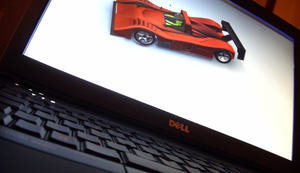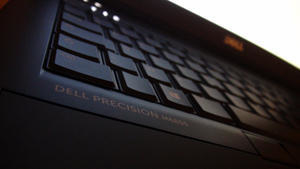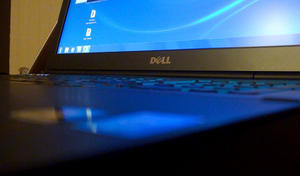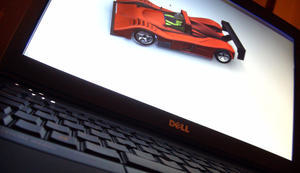DELL`s mobile Workstations im CADplace-Test: Die neue DELL Precision M6800 und die DELL Precision M3800
CADplace hatte das Glück und die Möglichkeite zwei super mobile Workstations von DELL miteinander zu vergleichen: Zum Einen die "Allzweckwaffe", die Precision M6800, und zum Anderen, die allerneueste, noch nie gesehene, nur 2 Kilo schwere Dell Precision M3800. Welche der Beiden ist für Sie die Bessere?
The Precision M6800 and the Precision M3800 are both professional, mobile workstations. After that point, they are completely different systems and your computing needs will decide which is right for you. Here is an overview of the two systems.
The Precision M6800 continues Dell's tradition of offering a mobile, desktop replacement workstation
The 2013 Precision M6800 updates the desktop replacement model from 2012, the Precision M6700. The raison d'être for this, the high-end of the Precision mobile line, is to provide a true desk-top replacement mobile workstation. The M6800 has the most capacity and the highest performance of all the Dell Precision mobile workstations. The look and feel of the new generation resembles strongly the previous model.
The Precision M3800 is a completely new development from Dell. The "3800" moniker implies a positioning in power and performance which lays below the two other Precision mobile products, but that is deceptive. The Precision M3800 has been designed as a powerful, yet light and stylish mobile workstation. And although it is a 15 inch model, it has a much much higher resolution than the Precision M6800
The Precision M3800 is a thin and light workstation to address a non-traditional Dell customer
The featured characteristics of the Precision M3800 include:
- The thinnest, lightest 15 inch workstation ever - weighs in at 1.88 kilograms
- Workstation power for high-end applications in CAD and professional video while on the road
- Excellent CPU performance with Intel 4th generation i7 processors and rendering and graphic power from the NVIDIA Quadro GPU
- An ultra-high resolution display : 3200x1800 pixels
- 5-finger support for the touch display
- Testing and certification with professional applications (ISV certifications)
The featured characteristics of the Precision M6800 include:
- Unequaled mobile power with options up to Intel Core i7 Extreme Edition CPU and NVIDIA Quadro K5100M GPU with 8GB GDDR5 memory
- Extensive storage options including 1 TB SATA drive and 512 GB SSD storage and easy, tool-free removal of primary disk for swapping or secure storage
- Expandable, high-performance memory : 32 GB of 1600MHz memory or 16 GB of 1866MHz memory
- Long battery life and rugged, durable design
In all areas, the Precision M6800 offers many more configuration options than the Precision M3800. This is a clear consequence of the thin and light trade-off made in the M3800 design.
Configurations for the Precision M6800 and the Precision M3800
Configuration | Precision M6800 | Precision M3800 |
Graphics Accelerator | NVIDIA Quadro K3100M (up to Quadro K5100M possible) | NVIDIA Quadro K1100M |
Total Graphics Memory | 4GB (K5100 has 8 GB) | 2GB |
Processor Type | Intel(R) Core(TM) i7-4800MQ CPU @ 2.70GHz (up to Core i7 Extreme Edition) | Intel(R) Core(TM) i7-4702HQ CPU @ 2.20GHz |
Processor Base Frequency | 2.7 GHz | 2.2 GHz |
System Memory | 16GB at 1600 MHz (up to 32 GB) | 16GB at 1600 MHz |
Weight starting at | 3.57 kg, 7.86 lbs | 1.88 kg, 4.15 lbs |
Operating System | Microsoft Windows 7 Professional 64 bits (ships with Windows 8.1 Pro license) | Microsoft Windows 8.1 Pro 64-Bit |
Interestingly, the differences in form and function of these two road warriors is so striking that the differences in performance seem banal. The fact is that the performance represents only a single aspect of your mobile workstation's utility. And that performance is dependent on the technology packed inside - plain and simple.
Since the graphics in both are based on NVIDIA Quardro chips using the latest GPU architecture, and since the same can be said for the Intel Core i7 CPUs in the two systems, then when we look at the performance numbers below, we see results which are completely compatible with the differences in the CPU and GPU configurations.
For those familiar with the Viewperf benchmark, you will recognize the lightwave test as more CPU-limited, hence the relatively smaller difference, where as the Catia test is often GPU limited and hence a slightly greater difference in performance. No surprises here.
The tests were run just weeks before the release of the new Specbench benchmarks. The new benchmark was not yet officially released, nor did it officially support Windows 8; therefore we won't use those numbers here.
Future reviews will use the new version of the tests. Unofficially, both systems ran the pre-released benchmark without issue and the performance comparison mirrors that of the Viewperf 11 tests.
Comparing the performance of the Precision M6800 and the Precision M3800 mobile workstations with SPEC Viewperf 11
Viewset | Precision M6800 | Precision M3800 | Viewset Description |
| catia-03 | 51.08 | 31.50 | The catia-03 viewset was created from traces of the graphics workload generated by the CATIA™ V5 R19 and CATIA V6 R2009 applications from Dassault Systemes. |
| ensight-04 | 33.05 | 17.63 | The ensight-04 viewset represents engineering and scientific visualization workloads created from traces of CEI's EnSight 8.2 application. |
| lightwave-01 | 51.72 | 48.49 | The lightwave-01 viewset was created from traces of the graphics workloads generated by the SPECapc for Lightwave 9.6 benchmark. |
| maya-03 | 54.95 | 46.76 | The maya-03 viewset was created from traces of the graphics workload generated by the SPECapc for Maya 2009 benchmark. |
| proe-05 | 19.24 | 13.84 | The proe-05 viewset was created from traces of the graphics workload generated by the Pro/ENGINEER Wildfire™ 5.0 application from PTC. Model sizes range from 7- to 13-million vertices. |
| sw-02 | 49.10 | 37.43 | The sw-03 viewset was created from traces of the graphics workload generated by the Solidworks 2009 SP2 application from Dassault Systemes. |
| tcvis-02 | 41.89 | 27.89 | The tcvis-02 viewset is based on traces of the Siemens Teamcenter Visualization Mockup application (also known as VisMockup) used for visual simulation. Models range from 10- to 22-million vertices and incorporate vertex arrays and fixed-function lighting. |
| snx-01 | 38.22 | 23.91 | The snx-01 viewset is based on traces of the Siemens NX 7 application. The traces represent very large models containing between 11- and 62-million vertices, which are rendered in modes available in Siemens NX 7. |
The Precision M6800 : your desktop workstation made for the road
The CADplace review of the previous generation : Dell Precision M6700 review : your desktop workstation made for the road, sounds familiar. The M6800 is the evolution, not the revolution in this review. In fact, many of the images from this year's review could have easily been from last year's review. It is an elegantly designed desktop replacement workstation.
The Precision M6800 supports Intel Core i7 Extreme Edition CPUs and NVIDIA Quadro K5100 professional GPUs. The previous model, the M6700, could take 2.5 TB of storage on the road with you. To be honest, it's not easy to divine the maximum capacity of the M6800, however, you probably don't want the absolute maximum capacity on this mobile workstation, either. You will probably want to combine the hard drive and SSD options. That gives you the capacity of traditional hard drives with the performance of modern SSD storage. Finally, the Precision M6800 supports a maximum capacity of 32 GB of main memory.
Efficient cooling and ISV certification lend to the reliability of the Precision M6800
The overall impression is one of durability. While that is true of the external appearances as well as the feeling of the case and keyboard, it is also the reality inside. The cooling system is designed to be quiet and efficient to keep your workstation running cool to extend the life of the system. Additionally, testing and certification with software vendors provide the system with that bullet-proof feeling inside.
As a desktop replacement workstation, it's likely to make sense to load this system to it's limits. Near maximum performance and capacity will guarantee your satisfaction on the road and in the office. And with a system configured to the limits of the system specification, the 240W power supply is more than a roll-bag-anchor, it is essential for the performance of your heavyweight road warrior. Imagine an Intel Core i7 Extreme Edition CPU, an NVIDIA Quadro GPU with 8 GB of graphics memory, 32 GB of system memory and 2 or more TB of main storage. That is the reason for the massive power supply.
The Precision M6800 supports Intel Core i7 Extreme Edition CPUs and NVIDIA Quadro K5100 professional GPUs.
As nicely designed as the Precision M6800 is, there are two areas which disappoint us at CADplace : the display resolution and the small touchpad. Neither has changed in several years. Take the resolution. It is essentially unbelievable that the Precision M6800, which sports the maximum capacity, speed, and performance in every way that a mobile workstation can offer, does not have a display resolution solution that exceeds 1920x1080.
Even a pre-retina display Macbook Pro from 2011 had a higher resolution. Bizarrely, you are able to configure this road warrior with a lower resolution display with a 1600x900 resolution. Finally, the M3800 simply quadruples that 1600x900 resolution offering 3200x1800 pixels on a 15 inch display. So why does the Precision M6800 still have a 1920x1080 display? Is it due to panel availability or a design decision?
Regarding the small touchpad, here, too, the design has not changed. The physical space for the touchpad remains small. In part, this is due to the double set of buttons - top and bottom of the touchpad. The double-buttons was a nice feature a few years ago. It provided a configuration that satisfies any user's touchpad preference. Touchpad technology has evolved. The modern touchpad avoids the button configuration problem by turning the touchpad into one large touchpad and button.
The display and the touchpad issues disappoint on this new generation of desktop replacement in part because the technology has moved on years ago and in part because this is the flag-ship, top-of-the-line mobile workstation. Hopefully these changes will come with the next generation - that hope comes from the fact that the Precision M3800 already delivers on both.
Precision M3800 : two kilos of stylish, thin, and light workstation
Until now, the price to pay for a professional, certified workstation has been schlepping around a real work-horse. Durable, solid, and a bit on the "heavy" side.
Until now.
The Precision M3800 doesn't try to be the ultimately configurable desk-top replacement mobile workstation which the Precision M6800 clearly is. The Precision M3800 design targets mobile professionals who need power on the road but do not want to feel like they are getting a work-out just by going to work.
In the weight category, this machine delivers great performance and weighs 1 kilo less than the other 15 inch Precision workstation, the M4800. Weight, while perhaps the primary objective, is not the only priority for the Dell Precision M3800.
This workstation has styling which targets a workstation user who doesn't want to look like a workstation geek. Dell openly talks about targeting a Macbook Pro customer with the M3800.
The design features an aluminum and carbon fiber chassis. The 8mm to 18mm thin format is well under half the height of the Precision M6800. A display resolution of 3200x1800 exceeds that of the current Macbook Pro. And the flat, back-lit keyboard and the large touchpad echo strongly the Macbook Pro system design.
The styling and weight impose certain restrictions on the configuration. The choices for expandability are limited. The Intel CPU and the NVIDIA Quadro choices are fixed.
The 3200x1800, five-finger touch-screen display can be down-graded to a 1920x1080 touch-screen, but I cannot imagine why any professional would chose that option.The memory selection can be either 8 GB or 16 GB.
The M3800 allows for a range of options for the two storage slots allocated and you can find all the options in the data sheet below. Here, I would advise readers to consider the best SSD option their budget can afford.
Our own experience and the educated perspective of CADplace partners show that SSD storage delivers a performance increase of five to ten times the speed of conventional magnetic storage media. This provides a fast, snappy response with applications that increases productivity.
Which Precision mobile workstation will you chose?
The Precision M6800 and M3800 offer mobility, certification, reliability, and performance. Should your work have off-the-chart performance needs in computing, graphics, or storage, you're choice will be the Precision M6800.
On the other hand, your work may be very demanding but still lay well within the capacity of the Precision M3800. You'll find yourself with a lighter load and a ultra-high resolution display for a productive mobile working environment.
Download the Dell Precision M6800, M4800, and M3800 mobile workstation data sheets
Precision M6800 | Precision M4800 | Precision M3800 |



